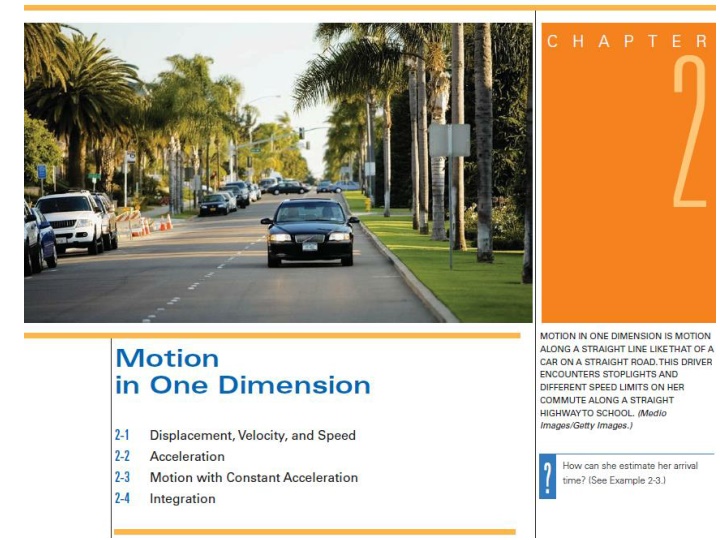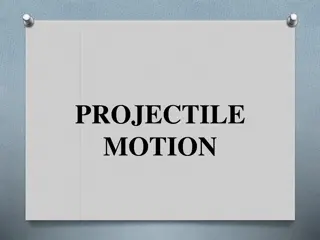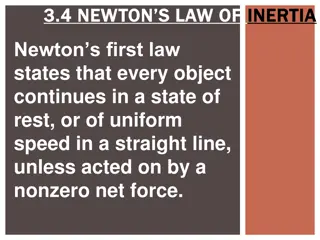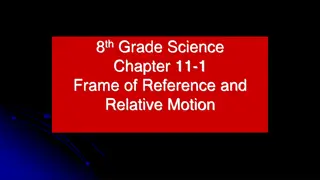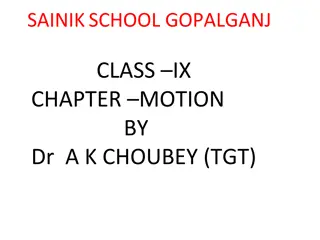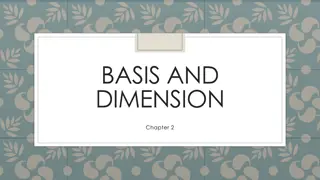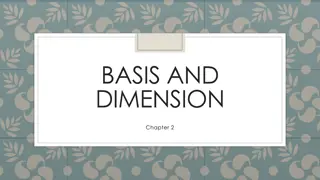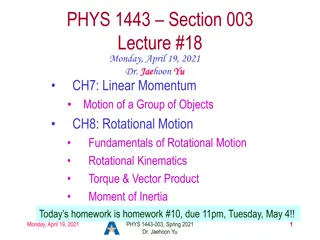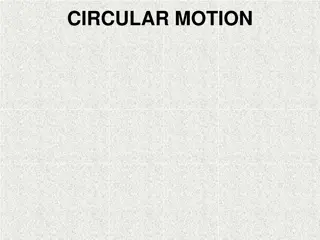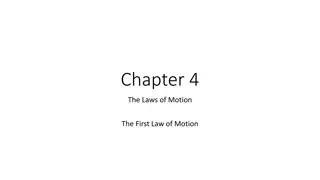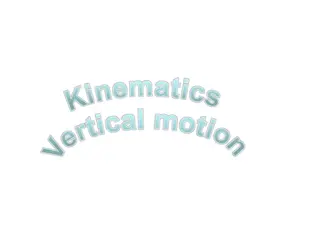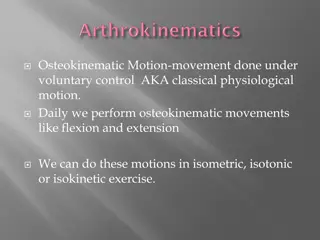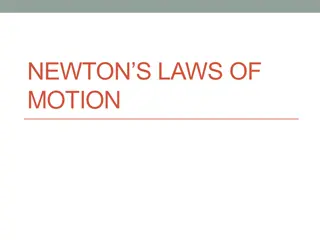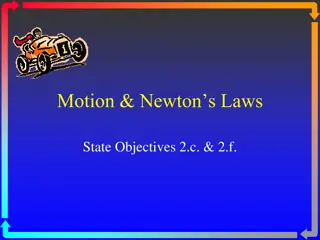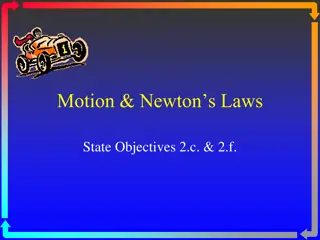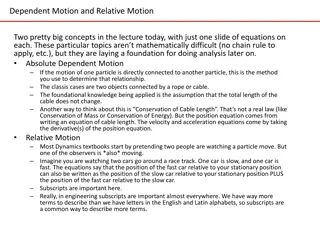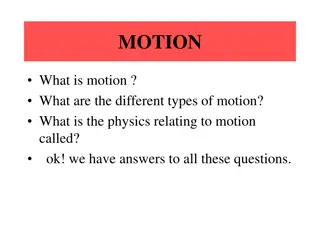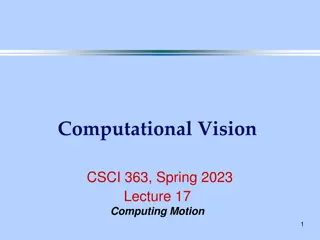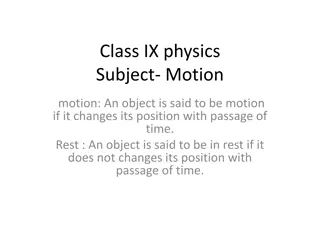Introduction to Motion in One Dimension
Motion in one dimension is the study of objects moving along a straight line. This chapter delves into kinematics, describing position, displacement, distance traveled, average speed, and average velocity. Understanding these concepts is crucial for comprehending mechanics and dynamics in physics.
Download Presentation

Please find below an Image/Link to download the presentation.
The content on the website is provided AS IS for your information and personal use only. It may not be sold, licensed, or shared on other websites without obtaining consent from the author.If you encounter any issues during the download, it is possible that the publisher has removed the file from their server.
You are allowed to download the files provided on this website for personal or commercial use, subject to the condition that they are used lawfully. All files are the property of their respective owners.
The content on the website is provided AS IS for your information and personal use only. It may not be sold, licensed, or shared on other websites without obtaining consent from the author.
E N D
Presentation Transcript
INTRODUCTION MOTION IN ONE DIMENSION IS MOTION ALONG A STRAIGHT LINE LIKE THAT OF A CAR ON A STRAIGHT ROAD. THIS DRIVER ENCOUNTERS STOPLIGHTS AND DIFFERENT SPEED LIMITS ON HER COMMUTE ALONG A STRAIGHT HIGHWAY TO SCHOOL. How can she estimate her arrival time? The study of motion, and the related concepts of force and mass, is called mechanics. We begin our investigation into motion by examining kinematics, the branch of mechanics that deals with the characteristics of motion. You will need to understand kinematics to understand the rest of this course. Motion permeates all of physics, and an understanding of kinematics is needed to understand how force and mass effect motion. Starting in Chapter 4, we look at dynamics, which relates motion, force, and mass.
Position & Displacement. To describe the motion of a particle, we need to be able to describe the position of the particle at different times. For example, the shown figure shows a student on a bicycle at position xiat time ti . At a later time, tf, the student is at position xf. The change in the student s position, xf -xi ,is called a displacement. We use the Greek letter (uppercase delta) to indicate the change in a quantity; thus, the change in x can be written as
Important Note. It is important to recognize the difference between displacement and distance traveled. The distance traveled by a particle is the length of the path a particle takes from its initial position to its final position. Distance is a scalar quantity and is always indicated by a positive number. Displacement is the change in position of the particle. It is positive if the change in position is in the direction of increasing x (the + x direction), and negative if it is in the - x direction Example 1 : You are playing a game of catch with a dog. The dog is initially standing near your feet. Then he jogs 20 feet in a straight line to retrieve a stick, and carries the stick 15 feet back toward you before lying on the ground to chew on the stick. (a) What is the total distance the dog travels? (b) What is the net displacement of the dog? (c) Show that the net displacement for the trip is the sum of the sequential displacements that make up the trip.
Average Speed The average speed of a particle is defined as the total distance traveled by the particle divided by the total time Because the total distance and total time are both always positive, the average speed is always positive. Average Velocity The average speed describes how fast is the particle is moving. The more useful quantity is the average velocity which describes how fast and in which direction the particle is moving.
Example 2. The dog that you were playing catch with in Example 1 jogged 20.0 ft away from you in 1.0 s to retrieve the stick and ambled back 15.0 ft in 1.5 s (see the figure. Calculate (a) the dog s average speed, and (b) the dog s average velocity for the total trip.
Example 3. It normally takes you 10 min to travel 8.3 km to school along a straight road. You leave home 15 min before class begins. Delays caused by a broken traffic light slow down traffic to 33 km/h for the first 3.3 km of the trip. Will you be late for class? 8.3 km/10 min x 1000 m/km x 1 min/60 s = 13.8 m/s 3.3 km/33 km/h = .1 h x 3600 s/h = 360 s ((8.3 3.3) km x 1000 m/s) /13.8 m/s = 360 s (360 s + 360 s) x 1 min/60 s = 12 min You will not be late.
Instantaneous Velocity and Speed. Often we need to know the velocity of a particle at a particular instant in time, rather than the average velocity over a finite time interval The instantaneous velocity of a particle at some point is the slope of the line tangent at that point In calculus, this limit is called the derivative of x with respect to t and is written dx/dt. Using this notation, the above equation becomes:
Example 4. The position of a particle as a function of time is given by the curve shown in the Figure . Find the instantaneous velocity at time t =1.8 s. When is the velocity greatest? When is it zero? Is it ever negative? Change in y/Change in x = 4.5 m/6 s = .75 m/s The graph has the greatest slope at t = 4 s, so that is when the velocity is greatest. The slope (and the velocity) goes to zero at t = 6 s The slope (and the velocity) is negative after t = 6 s
Example 5. The position of a stone dropped from a cliff is described approximately by ? ? = 5?2, where x is in meters and t is in seconds. The x direction is downwards and the origin is at the top of the cliff. Find the velocity of the stone during its fall as a function of time t.
When you step on your cars gas pedal or brake, you expect your velocity to change. An object whose velocity changes is said to be accelerating. Acceleration is the rate of change of velocity with respect to time. The average acceleration, aav x, for a particular time interval t is defined as the change in velocity, ?, divided by that time interval: Average acceleration Instantaneous acceleration
Example 6. In the shown figure, match each vx-t graph on the left with the ax -t graph on the right that best describes the motion.
Example 7. A cheetah can accelerate from 0 to 96 km/h (60 mi/h) in 2.0 s, whereas a Corvette requires 4.5 s. Compute the average accelerations for the cheetah and Corvette and compare them with the free-fall acceleration, g = 9.81 m/s2.
Example 7. A particle moves along the x axis. Its position varies with time according to the expression ? ? = 3?2+ 5? + 2 where x is in meters and t is in seconds. (a) Determine the displacement of the particle in the time intervals t = 0 to t = 1 s (b) Calculate the average velocity during these two time intervals. (c) Find the instantaneous velocity of the particle at t = 2.5 s. (d) Calculate the average acceleration during these two time intervals. (e) Find the instantaneous acceleration of the particle at t = 2.5 s.
Constant Acceleration The gravity is an example of constant acceleration. ( ) In case of a constant acceleration, the average acceleration is also constant and has the same value. That is Kinematic Equations (3 Equations) Recall but Suppose , then , and the above equation can be written as 1
By definition, we have and Using Equation (1) and , then the above equation is written as 1 2 By substituting the value of t from Equation in Equation , we can get 1 3
Example 8 : As you brake your car to stop, the velocity decreases at constant rate of (5.0 m/s2). What is the car stopping distance if your initial velocity is (a) 15 m/s or (b) 30 m/s (c) how much time does it take for the car to stop if its initial velocity is 30 m/s, and (d) how far does the car travel in the last second?
Example 9 : A car is speeding at a constant 90 km/h in a school zone. A police car starts from rest just as the speeder passes by it and accelerate at constant rate of 5.0 m/s2 . (a) When does the police car catch the speeding car. (b) How fast is the police car traveling when it catches up with the speeder.
Example 10 : A ball is dropped from rest at height of 50 m above the ground. (a) What is its speed just before hits the ground? (b) How long does it take to reach the ground?
